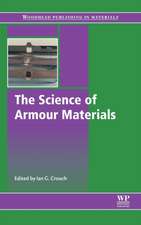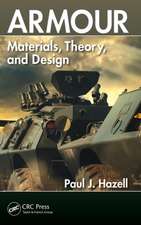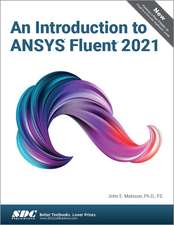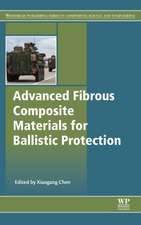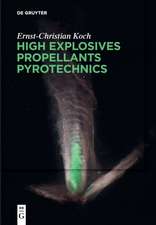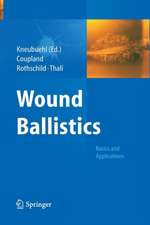Terminal Ballistics
Autor Zvi Rosenberg, Erez Dekelen Limba Engleză Hardback – 2 iun 2020
This new, 3rd edition reflects a number of recent advances in materials science, such as the use of polyurea layers on metallic plates in order to improve their ballistics. In addition, more data and analyses are now available on dwell and interface defeat in ceramic tiles coated with polymers, and are presented here. Lastly, the new edition includes new results, numerical and empirical, concerning the DIF issue in brittle solids, as well as the “upturn” phenomenon in the stress–strain curves of ductile solids.The author also added a new analysis of concrete penetration experiments which accounts for the scaling issue in this field. This is a new,and important, addition which we are happy to announce. They also added some new insights into the interaction of EEP’s and FSP projectiles with metallic plates.
Throughout thebook, the authors demonstrate the advantages of the simulation approach in terms of understanding the basic physics behind the phenomena investigated, making it a must-read for all professionals who need to understand terminal ballistics.
| Toate formatele și edițiile | Preț | Express |
|---|---|---|
| Paperback (3) | 783.20 lei 6-8 săpt. | |
| Springer Berlin, Heidelberg – 16 apr 2014 | 783.20 lei 6-8 săpt. | |
| Springer Nature Singapore – 31 mar 2018 | 893.84 lei 6-8 săpt. | |
| Springer International Publishing – 2 iun 2021 | 1004.81 lei 6-8 săpt. | |
| Hardback (1) | 1010.96 lei 6-8 săpt. | |
| Springer International Publishing – 2 iun 2020 | 1010.96 lei 6-8 săpt. |
Preț: 1010.96 lei
Preț vechi: 1232.88 lei
-18% Nou
Puncte Express: 1516
Preț estimativ în valută:
193.45€ • 206.86$ • 161.29£
193.45€ • 206.86$ • 161.29£
Carte tipărită la comandă
Livrare economică 17 aprilie-01 mai
Preluare comenzi: 021 569.72.76
Specificații
ISBN-13: 9783030466114
ISBN-10: 3030466116
Ilustrații: XIII, 403 p. 321 illus., 37 illus. in color.
Dimensiuni: 155 x 235 mm
Greutate: 0.76 kg
Ediția:3rd ed. 2020
Editura: Springer International Publishing
Colecția Springer
Locul publicării:Cham, Switzerland
ISBN-10: 3030466116
Ilustrații: XIII, 403 p. 321 illus., 37 illus. in color.
Dimensiuni: 155 x 235 mm
Greutate: 0.76 kg
Ediția:3rd ed. 2020
Editura: Springer International Publishing
Colecția Springer
Locul publicării:Cham, Switzerland
Cuprins
Part 1. Experimental and Numerical Techniques.- Chapter 1. Experimental Techniques.- Chapter 2. Material Models for Numerical Simulations.- Part 2. Penetration Mechanics.- Chapter 3. Rigid Penetrators.- Chapter 4. Plate Perforation.- Chapter 5. Eroding Penetrators.- Part 3. Defeat Mechanisms.- Chapter 6. Defeat by High Strength Targets.- Chapter 7. Asymmetric Interactions.
Textul de pe ultima copertă
This book comprehensively discusses essential aspects of terminal ballistics, combining experimental data, numerical simulations and analytical modeling.
This new, 3rd edition reflects a number of recent advances in materials science, such as the use of polyurea layers on metallic plates in order to improve their ballistics. In addition, more data and analyses are now available on dwell and interface defeat in ceramic tiles coated with polymers, and are presented here. Lastly, the new edition includes new results, numerical and empirical, concerning the DIF issue in brittle solids, as well as the “upturn” phenomenon in the stress–strain curves of ductile solids.The author also added a new analysis of concrete penetration experiments which accounts for the scaling issue in this field. This is a new,and important, addition which we are happy to announce. They also added some new insights into the interaction of EEP’s and FSP projectiles with metallic plates.
Throughout thebook, the authors demonstrate the advantages of the simulation approach in terms of understanding the basic physics behind the phenomena investigated, making it a must-read for all professionals who need to understand terminal ballistics.
This new, 3rd edition reflects a number of recent advances in materials science, such as the use of polyurea layers on metallic plates in order to improve their ballistics. In addition, more data and analyses are now available on dwell and interface defeat in ceramic tiles coated with polymers, and are presented here. Lastly, the new edition includes new results, numerical and empirical, concerning the DIF issue in brittle solids, as well as the “upturn” phenomenon in the stress–strain curves of ductile solids.The author also added a new analysis of concrete penetration experiments which accounts for the scaling issue in this field. This is a new,and important, addition which we are happy to announce. They also added some new insights into the interaction of EEP’s and FSP projectiles with metallic plates.
Throughout thebook, the authors demonstrate the advantages of the simulation approach in terms of understanding the basic physics behind the phenomena investigated, making it a must-read for all professionals who need to understand terminal ballistics.
Caracteristici
Pursues a unique approach, using numerical simulations as sensitivity measures Helps readers gain an understanding of the basis of physics behind the phenomena investigated Combines experimental data, numerical simulations and analytical modeling Includes new modeling approaches for thick concrete walls, thin concrete slabs, and thick metallic plates


